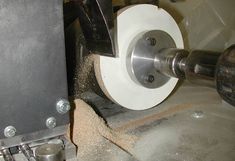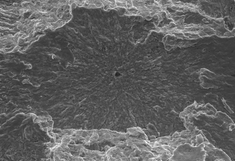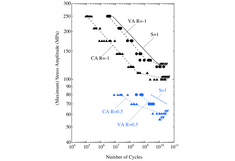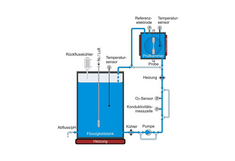Development of resource efficient material cutting methods
The field of materials processing technology is an energy and material intensive area. Savings in the field of material utilization, e.g. thin cutting technologies, have direct impact on the productivity of an enterprise.
Energy savings will help save energy resources and can be achieved by new processing technologies. Ultrasonically assisted cutting a technology developed at the institute combines conventional cutting with an additional kinetic and may reduce static cutting forces below 20% compared to conventional cutting.
Contact: G. Sinn
Influence of microstructural variability on cyclic strength
Fatigue crack initiation and growth and the associated cyclic properties and fatigue life of materials are substantially influenced by microstructural features which can cause stress concentrations or enhanced cyclic slip. Shrinkage, gas porosity, oxide surfaces, primary participates, intermetallic inclusions or large grains may be sources of fatigue cracks. Microstructural analysis is conducted by using Field Emission Scanning Electron Microscopy accompanied by Energy-dispersive X-ray Spectroscopy to characterize the crack initiating material inhomogeneities. Contact: H. Mayer
In service fatigue measurement and prediction in the very long life regime
Load bearing components are often stressed with varying amplitude in service whereas fatigue data of materials are mainly available for constant amplitude loading. In the very high cycle regime, the link between constant and variable amplitude loading is hardly investigated. The ultrasonic methods has been developed to make in-service loading experiments possible and to accumulate material properties in the very long life regime within relatively short testing times. Contact: H. Mayer, B. Schönbauer
Corrosion fatigue testing, fatigue testing at elevated temperatures
Environmental medium and temperature have significant impact on the fatigue behaviour of materials. Generally, with increasing corrosiveness the lifetime is decreases while fatigue crack growth rates may be reduced due to crack closure effects. Equipment for fatigue testing in vacuum, gaseous environments and liquids at various temperatures are available. Beside fatigue strength and crack growth rates, it is possible to determine corrosion potential, oxygen content und conductibility in aqueous solutions. Furthermore, we have a wide experience in pitting corrosion which in many areas of application, e.g. steam turbines, causes premature damage
Contact: H. Mayer, B. Schönbauer
Fatigue damage monitoring and modelling
In-situ monitoring of fatigue damage in materials can be difficult or even impossible, if fatigue cracks form internally, at inclusions or porosity, for example. Analysis of the spectral vibration properties of the specimen vibrating in resonance can be used to detect fatigue damage. Non-linear acoustic properties, evolution of harmonics and analysis of power signals serve to indirectly monitor the progress of fatigue damage. Contact: H. Mayer





